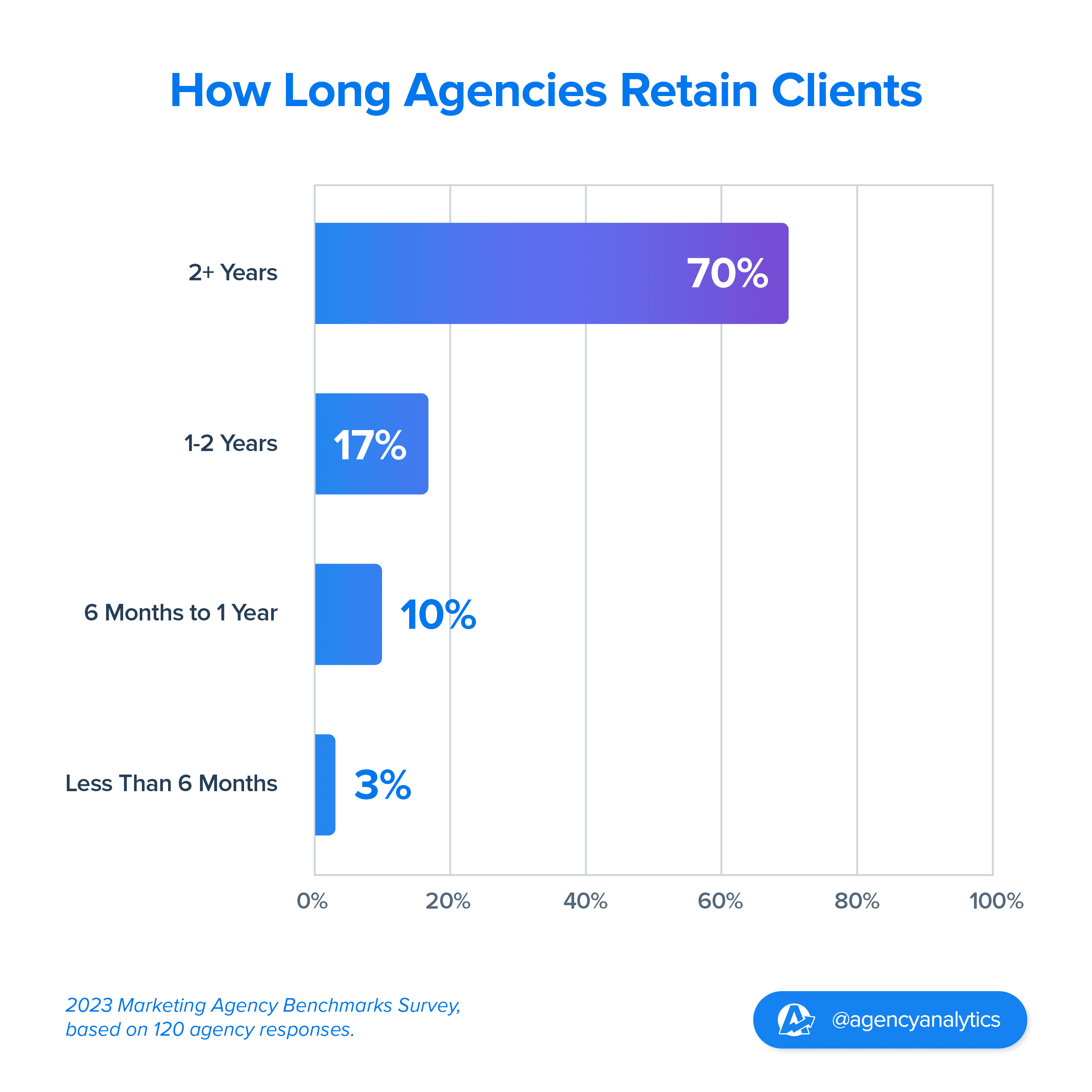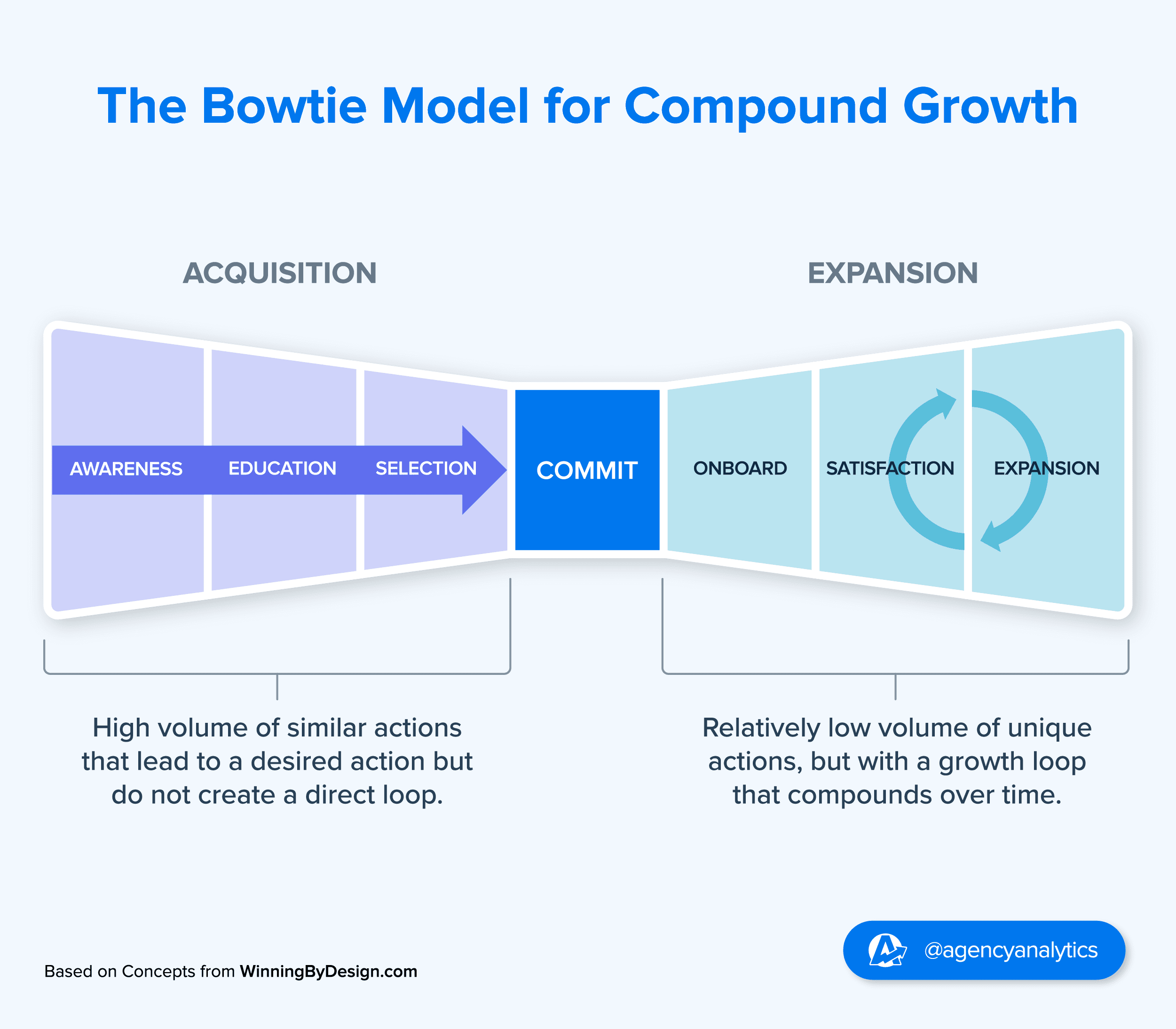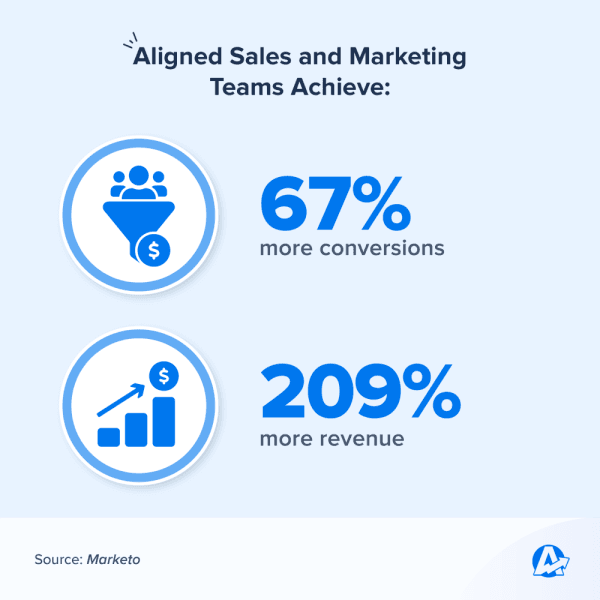Table of Contents
QUICK SUMMARY:
The Bowtie Model is a strategic framework for client acquisition and retention, focusing on both customer onboarding and revenue expansion. This article explains how the Bowtie Model applies to marketing agencies, highlighting its dual focus on acquiring new clients and enhancing post-acquisition engagement for sustained growth.
At AgencyAnalytics, we frequently liaise with over 7,000+ agencies, which puts us in a unique position to understand their evolving needs and challenges. It’s what enables us to gather data-driven insights and extrapolate upcoming agency trends.
Recently, agencies have had to innovate and strategically pivot in the face of economic uncertainty. Increasingly, the focus has expanded from pounding the pavement and landing new clients to a more active engagement in the post-acquisition phase, as agencies explore recurring revenue business models to enhance client retention.
Adopting a recurring revenue model has numerous benefits, from steady cash flow to improved strategic planning. It’s not a passive exercise–it’s the byproduct of exceptional customer service and putting the right post-acquisition plan in motion.
In this article, we’ll share actionable perspectives on client retention–including the Bowtie model–and how they apply to agencies. Using insights from our Marketing Agency Benchmarks Report, we’ll explore key data findings and how to use them to maximize your agency’s revenue potential.
The Changing Face of Agency Growth
While client acquisition is vital for agency growth, retention is an arguably larger priority. Recurring revenue acts as a safety net to keep agencies afloat during times of economic uncertainty.
Adopting a recurring revenue model goes beyond a transactional business approach. Instead, it’s a systematic course of action that prioritizes customer interactions, ensures predictable revenue, and buffers against changing market tides.
The latter is crucial, considering that 2023 started with the hopes of an economic pickup. While cautious optimism is always preferred, 2024 projections seem less promising. The market may experience a slower-than-expected recovery, compounded by rising interest rates and persistent inflation.
Therefore, a sole reliance on client acquisition is a high-risk strategy. Agencies must instead strategically buffer against downturns by leveraging the full revenue potential of existing relationships.
Cash flow helps you meet financial obligations. It enables you to plan for the future. And it helps you decide when to push the accelerator or pull back–depending on what’s happening in your industry or amongst your team.
Dan Delmain, Founder, :Delmain
Taking a closer look at the stats, our Marketing Agency Benchmarks Survey showed that in 2023 agencies experienced an approximate 30% client drop-off rate after two years.

This customer churn seems modest, but there are obvious implications for revenue. Retaining 5% more clients can boost profits from 25% to 95%, which means a recurring revenue model is definitely worth looking into.
Flipped on its head, agencies could look at it this way: A wavering retention rate is a growth opportunity in disguise. While it depends on the project scope, short-term client engagements are often missed opportunities for long-term relationships and increased monthly recurring revenue. In this way, agencies stand to benefit from shifting time allocation from strictly acquisition activities to also upselling existing clients.
Losing existing clients is the biggest danger to a marketing agency facing a downturn. In business, “your current customer is your cheapest customer.” When faced with economic uncertainty, our focus shifts to client retention. It’s an all-hands-on-deck approach to avoid disruption to existing client relationships.
Dan Delmain, Founder, :Delmain
From First Contact To Lasting Partnerships
Monday.com's co-CEO, Eran Zinman, recently gave a SaaStr talk illustrating the profound impact of customer retention on revenue. To be more specific, a staggering 85% of their revenue came from existing customers–over $700M.
While SaaS companies operate differently from agencies, there’s a critical lesson to be learned here–customer retention is not a happy accident. It’s the result of deliberately focusing on relationship-building, delivering exceptional service, and adapting to evolving customer needs.
From our observations, niche specialization boosts client retention, a trend we’ve seen in established agencies like The Modern Firm. Interestingly, this legal marketing agency has retained some clients for 10+ years, all in the absence of long-term contractual agreements.
Instead, Chard emphasizes that exceptional service naturally engenders loyalty, allowing clients to continually choose the partnership with free will.
Moving the focus further down the digital agency life cycle also means having more power in choosing who to work with. For The Modern Firm–an agency with a 20-year track record–it means sticking to their values and passing on anything that doesn’t align.
If a client isn’t a good fit, it’s just bad all around–demoralizing for the team and frustrating for the client. To avoid this, we try to be upfront and determine whether they’re a good fit at the outset. This ensures a collaborative relationship, which increases the chances that they’re happy with their services and can take advantage of everything we can do.
Brendan Chard, Founder, The Modern Firm
By intentionally assessing prospective clients, The Modern Firm operates with a loyalty-based mindset from the start. Even after onboarding, they remain adaptable by adjusting marketing packages if needed and maintaining flexibility in the agency-client relationship.
Read More: Building a 20+ Year Legacy in the Legal Marketing Niche
The Shift From Project-Based to Subscription Services
Over the past decade, the tech industry has transitioned from on-site infrastructure and single-purchase software to subscription-based, recurring revenue models.
In contrast to the project-based model–where relationships are typically short-lived and centered around single tasks–a subscription model cultivates enduring partnerships. Lately we’ve seen agencies increasingly embrace this strategy, aiming for a more profitable business model.
LeaseMyMarketing is a Pennsylvania-based agency that puts these sentiments into practice. This decision was driven by the need for more predictable revenue streams, which significantly restructured the company's approach to client management.
Founder Adam Allen observed that clients often needed help understanding their marketing data. Adopting a subscription model allowed more time for cultivating relationships and offering continuous support.
Over time, the benefits of a recurring revenue business model were clear: It stabilized their revenue projections, ensuring enough capital for recurring overheads like staff salaries. For their clients, it represented a cost-saving option that eliminated the uncertainty of hourly or ad-hoc costs, especially for ongoing projects.
By having the client sign on for ongoing services, we get to know them better, provide better recommendations, and generate recurring revenue. Plus, I didn’t want my team to constantly track down the next sale every month and live off what was coming in the door. I not only needed more predictable revenue streams but also automated, efficient internal processes in place to scale.
Adam Allen, Founder, LeaseMyMarketing

Share visual marketing data that clients will understand. Invest in a reporting system that keeps clients on board and leads to recurring revenue–try AgencyAnalytics today, free for 14 days.
The Bowtie Model as a Retention Roadmap
Conceptualized by the Winning by Design team, the Bowtie Model offers a comprehensive strategy for acquiring and retaining clients–a critical component of any agency’s growth trajectory.
Like a bowtie, this Revenue Architecture framework is characterized by two distinct funnels: customer acquisition and expansion.

Landing new clients is one part of the process. But customer retention heavily depends on the Expansion phase, which involves effective onboarding, continuous satisfaction, and capitalizing on revenue-growing opportunities. The continuous feedback loop at the post-acquisition stage means potential for compounded revenue growth, which is only possible through nurturing the relationship.
To execute the bowtie model framework effectively, your team must agree on particular outcomes to track at each stage.
The acquisition stage closely resembles a conversion funnel (which you’re already familiar with). Here’s some added context:
During the awareness phase, prospects (i.e., Visitors) become familiar with your agency and services.
Interested MQLs enter the pipeline at the Education phase, some of whom are nurtured into SQLs.
Nurturing SQLs leads to Opportunities where your agency addresses concerns and reiterates a strong value proposition. Once all goes well, this leads to a client’s commitment.

In the bowtie model, the Expansion phase does not emphasize immediate actions as much as the Acquisition stage (where closing the deal is a primary focus).
Therefore, it’s up to your agency to define clear targets for greater efficiency and deepening agency-client partnerships over time. This may look like setting time limits for:
The client onboarding phase.
Successfully executing your client’s first campaign.
Hitting a predefined target, like monthly KPIs or OKRs.
A revenue-boosting event (such as an upsell).
Client retention and revenue growth aren’t left to chance. Instead, it’s methodologically planned to maximize growth potential, providing actionable targets for each agency team member to work towards.
A Personalized Approach to Client Retention
Today, agencies have access to numerous resources to add more personalization to their services. In fact, a tailored approach is what sets elite agencies apart from average ones. But it goes beyond formatting tweaks or surface-level changes. Instead, it’s about understanding evolving needs and reporting on the results that clients actually care about.
Take RevenueZen–a Portland-based agency that adopted a client-centric approach to proving ROI. Often, clients didn’t understand their marketing results–much less how they contributed to the bottom line–which was a pain point that President Rocky Pedden saw time after time.
In a bold move, Pedden decided to bridge this gap by linking his agency’s reporting with a client’s CRM (like HubSpot or Salesforce).
Our North Star is customer success. We strongly believe that performance-based marketing is the route to go. And we should be able to make clear connections to client revenue. Even if results take time to build, the client should see some growth with respect to the revenue side of things.
Rocky Pedden, President, Revenue Zen
This led to a better alignment between sales and marketing efforts, showing a clearer revenue connection. This team synchronicity ultimately leads to better results, increased ROI, and better customer retention rates.

Data-Driven Insights To Grow and Maintain Your Client Base
Circling back to our Marketing Agency Benchmarks Report, agencies specifically identified the key areas that strengthen client retention. These are:
Keeping an open line of communication and ensuring transparency. This tactic was referenced multiple times, which shows the importance of regular check-ins and two-way discussions.
Building trust and strong agency-client relationships, which reiterates the importance of connection beyond a transactional relationship. Instead, it’s about being a partner with a vested interest in your client’s growth.
Streamlined delivery of results and performance updates. Agencies must show tangible results to reassure clients that their services are worth the investment.

Interestingly, 36% of agencies ranked “Effective Communication and Transparency” as the top client retention factor. It underscores the importance of having the right systems to track and share results effectively.
We differentiate ourselves by showing clients their true marketing ROI. Our AgencyAnalytics dashboard is the reason we can guarantee this knowledge to our clients. It aggregates their total marketing investment, total quote and sales value, and, ultimately, their ROI.
Gabriela Paiva, Marketing Manager, Digilatics
Realistically speaking, complex data isn’t intuitive for many clients because they’re preoccupied with high-level operations. It’s precisely what inspired Squeeze Marketing to offer straightforward reports to clients, ensuring they understand exactly what was accomplished.
Co-owner and Partner Michael Gasser also makes a concerted effort to report on Earned Media Value–an often overlooked metric that tracks organic social media impact through Impressions and Clicks.
It shows clients the financial benefits of their organic efforts since it often means less reliance on paid advertising. As a result, it reassures clients that their investments are indeed fruitful, directly impacting the bottom line through cost savings.
Social media agencies often focus on visibility. But we found that those aren’t the ones that matter when running a business. You have to have revenue coming in. We put ourselves in our clients' shoes and thought about what causes them frustration. We knew we’d probably have a better retention rate by simply eliminating these pain points.
Michael Gasser, Co-owner and Founder, Squeeze Marketing
Agency Tip: Save hours each month by streamlining your reporting with an earned media report template—customizable and ready to impress your clients.
Strategic Upselling Through Tangible Value
In addition to this revenue-driven approach, Squeeze Marketing looks for smart ways to include passive upselling, all while making it relevant to clients.
For example, a client may hire multiple agencies to work on different arms of marketing campaigns. If Squeeze Marketing is responsible for running Google Ads, they don’t just report on these results–they include available insights across other channels.
It often prompts clients to consider their agency for additional services if they see unsatisfactory data from another vendor’s campaigns. This strategy benefits both the clients, who get a fuller picture of their marketing efforts, and Squeeze Marketing, who experience business growth as a result.
Read More: How This Digital Agency Scaled On Their Reporting Prowess
An Outlook for the Year Ahead
While economic challenges are still at play, we’ll continue to see an adaptive and solution-oriented spirit for 2024. Agencies should aim to provide more integrated services, considering the entire spectrum of marketing performance rather than just the impact of individual campaigns.
Client acquisition continues to be a must-have for a sustainable business momentum. But implementing the Bowtie Model revolutionizes the post-acquisition process, emphasizing the importance of long-term client relationships for continuous revenue generation.
The goal isn't to make hasty changes or overhaul operations entirely. It's about critically assessing your agency's structure and identifying untapped opportunities that are already at your fingertips.
Sound data tracking will likely remain the cornerstone of decision-making, and agencies will prioritize it more than before. Adopting this approach ensures that client campaigns remain relevant, all while proving tangible results through solid reporting.
A major benefit we sought from a reporting platform was improved client retention. By delivering comprehensive and insightful reports through AgencyAnalytics, we were able to demonstrate the value of our services, leading to increased client satisfaction and long-term partnerships.
Jessica Crist, Production Manager, High Five Media
Agencies that seize the opportunity to prioritize client success post-acquisition will reap the rewards of recurring revenue. They'll also benefit from a safety net and revenue accelerator that will boost their results in 2024 and beyond.
Invest in the right infrastructure to ensure your agency lives up to its full revenue potential. Try AgencyAnalytics, the client reporting tool used by 7,000 agencies and counting–it’s free for 14 days.

Written by
Jacob is an entrepreneurial and hands-on senior B2B SaaS marketing and sales executive with over 15 years of related experience with startups and scaleups. He builds data-driven centers of excellence in revenue operations that result in consistent growth in revenue (ARR) and customers.
Read more posts by Jacob VargheseSee how 7,000+ marketing agencies help clients win
Free 14-day trial. No credit card required.






